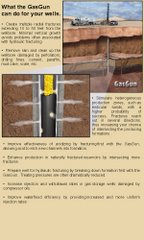I have heard in my travels across the midwest the word "Doodlebugger", a quack who professes to be able to mysteriously find oil. As I research new methods to help find oil, I am always skeptical, but recently came across technology that seems very promising: Hyperspectral Imaging.
So what is hyperspectral imaging? In layman's terms it measures the elemental signature at the earths surface. From data collected from satellites, the earth's surface is portrayed in millions of different colored pixels. Each pixel is a fingerprint of the chemical elements and molecular compounds found. Studies have shown that hydrocarbon seepage can be found at the earths surface and creates what we view as "hotspots" that warrant further analysis. This technology up until recently was only used by the big boys in the oil industry, but now can be reasonably added to an exploration budget of most small indepedent oil explorers.
One company in West Virginia, Quickstrike, www.yourquickstrike.com has utilized this technology plus other geochemistry to refine their search for oil/gas. Their sister company Geo-Max exploration has successfully built an impressive track record of oil and gas finds. Pete Hall and Jack Vires are very easy to talk to and can answer any questions or concerns you have regarding this technology. This is a close family run business, which is one of the "elements" I like to see in companies I have relationships with.
My company, Dynamic Natural Resources and Hughes Energy, Fairfield-IL, plan on utilizing hyperspectral imaging in upcoming months. We will create a 2 mile by 2 mile snapshot of the area we are prospecting. Once we have attained the hotspots, we will utilize "side looking airborne radar" to locate the main fractures. Overlaying the fracture map and the "hotspots", give us a fantastic starting point for further research.
When a hotspot and multiple fractures converge this creates the perfect environment for an accumulation of oil. More fractures create voids and higher permeability, thus more areas for oil to accumulate.
To further confirm our findings, we then utilize geochemistry. As oil and gas vertically migrate to the surface over millions of years they change the soil, plants, and water. Where oil seeps, bacteria live in the soil and "feed" on the hydrocarbons. Soil samples can show us where the bacteria are concentrated and these results can be put into a computer to be graphically displayed on our maps. Also, bacteria resperate CO2 when they feed on the hydrocarbons and we will test for higher concentrations.
I can't explain the chemistry behind the next geochemical test, but iodine has been a reliable indicator of hydrocarbon intensity. We measure via soil samples and map using gps coordinates. The high concentrations also validate our thesis of oil seepage.
Last but not least, we will utilize soil gas analysis. Gas is made up of mostly methane and oil mostly pentane and butane. We can find some of the large microseepage using this technique and the ratio of oil/gas.
I am confident that utilizing cutting edge technology will allow us to have above average success in the field. Remember, oil well investing always carries risk even when you find the oil.
In future articles, I will be interviewing various explorers that have utilized these technologies and updating readers on our progress in the field.
Subscribe to:
Post Comments (Atom)







No comments:
Post a Comment